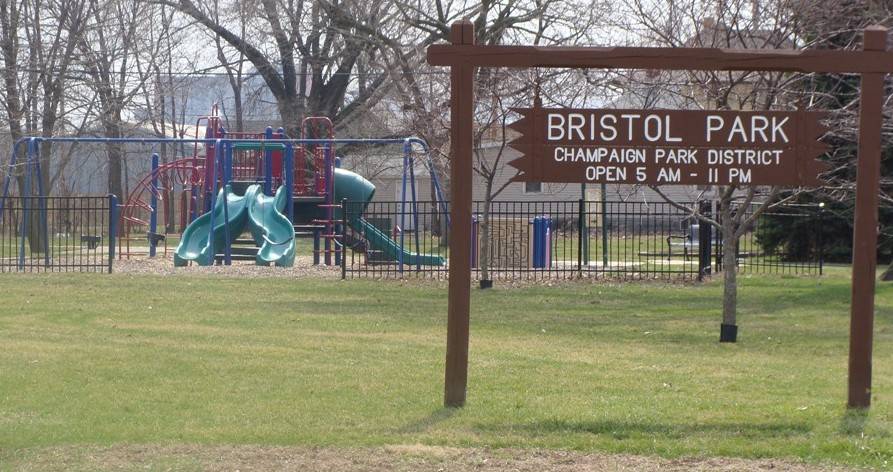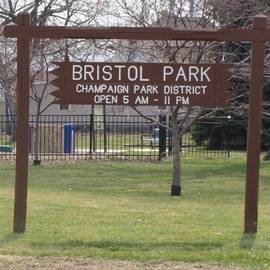This article first appeared on May 31 on ucimc.org.
This summer, the City of Champaign will begin the process of demolishing a neighborhood in the north end of the city. Bristol Place, northeast of Bradley and Market and home to nearly 200 residents, has been slated for total demolition by the city because of its low property values, old building stock, and a purportedly high rate of crime. The city will use eminent domain to acquire the properties from even those residents who wish to stay in the neighborhood and who own and occupy houses that are in good condition. Although the city has been clear to say that the neighborhood’s total demolition is a settled issue, many questions remain: Why was the neighborhood regarded as obsolete? What’s next for residents? Is this a process that we will see for other low-income, predominately African-American neighborhoods in Champaign?

On April 29, the League of Women Voters hosted a public forum to try to answer some of those questions, and invited Kevin Jackson, Director of the Neighborhood Services Department, Reverend Eugene Barnes of the Metanoia Center, and Rachel Phillips, an experienced public sector planner and recent graduate of UIUC’s Urban Planning program. The forum consisted of a series of prepared questions from a League moderator followed by comments and questions from the thirty-person audience. The panel began with a review of the city’s recent involvement in the neighborhood. A four-year planning process culminated with the Bristol Park Neighborhood Plan in 2011, which called for targeted reinvestment in the form of infill development and rehabilitation of deteriorating properties. Twelve months later, in early 2012, the city shifted to a policy of total demolition. Kevin Jackson claimed that the shift, from targeted reinvestment and preservation of the neighborhood to total demolition and redevelopment, came from a process of internal vetting and community outreach. He clarified that community outreach in this crucial phase of the plan was restricted to the opinions of local banks. Jackson reiterated the city’s noncommittal position regarding the character and content of a redeveloped Bristol Place, claiming that market conditions force them to be flexible to accommodate private investment.
This doctrine of flexibility requires a fully-assembled site, which the city plans to deliver after getting rid of current residents. For this initial phase, the city has been able to find more than $7.4 million from a mix of federal and local sources. This total includes $1.1 million from the Housing Authority of Champaign County (HACC), which has special flexibility with its HUD allocation because it is a Moving to Work agency. HACC resources approved for Bristol Place’s redevelopment in late 2012 can be used to either subsidize new housing costs for displaced residents (through what was formerly the Section 8 program — now known as housing choice vouchers) or could be project-based and subsidize new rental units in a redeveloped Bristol Place. The Housing Authority came under fire for its decision to help subsidize Bristol Place’s demolition last fall when local housing activist Terry Townsend organized a protest at the September meeting to demand that any current Champaign County residents wait-listed for rent subsidies should have priority over those displaced by voluntary government action.
For those displaced by the redevelopment plan, finding comparable housing promises to be a challenge. With the average rent in Bristol Place only about $560 for a 2BR unit, an increase of nearly $200 should be expected in Champaign’s rental market. Adding another layer of difficulty is the City of Champaign’s refusal to require landlords to accept housing choice vouchers. These forces could push many Bristol Place residents into Urbana or out of the twin cities completely, potentially isolating them socially and lengthening their commutes.
Clearly, a project with such heavy financial and social costs that offers little in the way of certainty for how the neighborhood will be redeveloped is a tough sell to current residents and the community. Responsibility to do so fell on the shoulders of Kevin Jackson and Neighborhood Services (NSD), a city department created in 1992 to “ensur[e] a comprehensive and effective response to neighborhood needs.” Despite being seemingly absent from the neighborhood from 1992–2012, NSD has swung into action over the last fifteen months to coordinate both the case management of buying out current property owners and putting a positive spin on the neighborhood’s publicly funded demise.
Over the past year, NSD has sold the plan to a variety of groups, including housing advocates, professional planners, religious institutions, and academics. In September 2012, NSD looked to gain the professional planning stamp of approval by entering a panel in the American Planning Association’s IL chapter conference titled “Starting Over: The Redevelopment of Bristol Place.” Public presentations in January and March of this year promoted the ideal of a new neighborhood designed to prime environmental and energy conservation standards. Community Development Specialist Gregg Skaggs went so far as to proclaim the city’s desire for a “magazine cover community” with sparkling amenities and people to match. Whether current residents, a significant share of whom are poor African-American women, fit into Skaggs’ picture is not clear.

The redevelopment of Bristol Place is not simply an official response to deteriorating neighborhood conditions; rather, it is a blueprint for urban renewal in the twenty-first century. Cities, intent on expanding their populations and tax revenue, must work subtly and with sophisticated rhetorical strategies to win public approval for gentrification. As was the case in the era of urban renewal, poor neighborhoods of marginalized peoples are not valued in a “community development” paradigm that prioritizes young professionals and students willing to pay high rents. The difference between the 1960s and the current moment is that public agencies lack the same broad mandates and access to capital they had back when HUD formed a much larger part of the federal government; today, they must patch together funding from a variety of sources and win public support for what amounts to very large and risky transfers of taxpayer dollars to private real estate developers. As Champaign has shown, cities must craft a public narrative of being “all about the residents,” while working behind the scenes to use their authority to advance private real estate interests that win coveted new residents willing to pay inflated rent.








